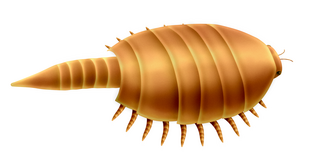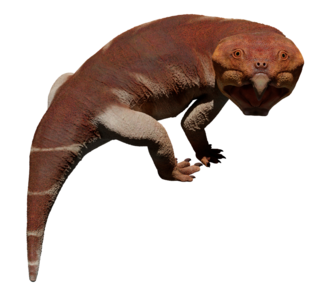
Thelodonti is a class of extinct Palaeozoic jawless fishes with distinctive scales instead of large plates of armor.

Drepanaspis is an extinct genus of heterostracan armoured jawless fish from the Early Devonian. Drepanaspis are assumed to have lived primarily in marine environments and is most commonly characterized by their ray-like, heavily armoured bodies, along with their lack of paired fins and jaws.

Jamoytius kerwoodi is an extinct species of primitive, eel-like jawless fish known from the Patrick Burn Formation in Scotland, dating to the Llandovery epoch of the Early Silurian period.
The Climatiiformes is an order of extinct fish belonging to the class Acanthodii. Like most other "spiny sharks", the Climatiiformes had sharp spines. These animals were often fairly small in size and lived from the Late Silurian to the Early Carboniferous period. The type genus is Climatius. The order used to be subdivided into the suborders Climatiida and Diplacanthida, but subsequently Diplacanthida has been elevated to a separate order, the Diplacanthiformes. The Diplacanthiformes take their name from Diplacanthus, first described by Agassiz in 1843. Family Gyracanthidae is sometimes rejected from this order.

The Nematophyta or nematophytes are a paraphyletic group of land organisms, probably including some plants as well as algae known only from the fossil record, from the Silurian period until the early Devonian Rhynie chert. The type genus Nematothallus, which typifies the group, was first described by Lang in 1937, who envisioned it being a thallose plant with tubular features and sporophytes, covered by a cuticle which preserved impressions of the underlying cells. He had found abundant disaggregated remains of all three features, none of which were connected to another, leaving his reconstruction of the phytodebris as parts of a single organism highly conjectural. No reproductive or vegetative structures common to the land plants are known, and certain members of the nematophyte plexus seem to belong to the fungi.

Drepanopterus is an extinct genus of eurypterid and the only member of the family Drepanopteridae within the Mycteropoidea superfamily. There are currently three species assigned to the genus. The genus has historically included more species, with nine species having been associated with the genus Drepanopterus. Five of these have since been proven to be synonyms of pre-existing species, assigned to their own genera, or found to be based on insubstantial fossil data. The holotype of one species proved to be a lithic clast.

Euthycarcinoidea are an enigmatic group of extinct, possibly amphibious arthropods that ranged from Cambrian to Triassic times. Fossils are known from Europe, North America, Argentina, Australia, and Antarctica.
Paleontology or palaeontology is the study of prehistoric life forms on Earth through the examination of plant and animal fossils. This includes the study of body fossils, tracks (ichnites), burrows, cast-off parts, fossilised feces (coprolites), palynomorphs and chemical residues. Because humans have encountered fossils for millennia, paleontology has a long history both before and after becoming formalized as a science. This article records significant discoveries and events related to paleontology that occurred or were published in the year 1960.

Paleontology or palaeontology is the study of prehistoric life forms on Earth through the examination of plant and animal fossils. This includes the study of body fossils, tracks (ichnites), burrows, cast-off parts, fossilised feces (coprolites), palynomorphs and chemical residues. Because humans have encountered fossils for millennia, paleontology has a long history both before and after becoming formalized as a science. This article records significant discoveries and events related to paleontology that occurred or were published in the year 2008.

Paleontology or palaeontology is the study of prehistoric life forms on Earth through the examination of plant and animal fossils. This includes the study of body fossils, tracks (ichnites), burrows, cast-off parts, fossilised feces (coprolites), palynomorphs and chemical residues. Because humans have encountered fossils for millennia, paleontology has a long history both before and after becoming formalized as a science. This article records significant discoveries and events related to paleontology that occurred or were published in the year 2009.

Ichthyostegalia is an order of extinct amphibians, representing the earliest landliving vertebrates. The group is thus an evolutionary grade rather than a clade. While the group are recognized as having feet rather than fins, most, if not all, had internal gills in adulthood and lived primarily as shallow water fish and spent minimal time on land.

Hyperodapedontinae is a subfamily of rhynchosaurs within the family Rhynchosauridae. Fossils have been found from Argentina, Brazil, Canada, India, Madagascar, Scotland, Tanzania, United States and Zimbabwe.
This list of fossil fish species is a list of taxa of fish that have been described during the year 2012. The list only includes taxa at the level of genus or species.
The Wood Bay Series is a geologic formation found on the island of Spitsbergen, Svalbard in Norway. It preserves fossils dating back to the Pragian–Emsian stages of the Devonian period.
Canonia is an extinct genus of jawless fish found in Canada. There are two species in this genus, C. grossi and C. costulata. The C.grossi specie is thought to be from the Devonian Period. Fossils of C.grossi have been found in the Boothia Peninsula.

Thyestiida is an order of bony-armored jawless fish in the extinct vertebrate class Osteostraci.

Panderodus Is an extinct genus of jawless fish belonging to the order Conodonta. This genus had a long temporal range, surviving from the middle Ordovician to late Devonian. In 2021, extremely rare body fossils of Panderodus from the Waukesha Biota were described, and it revealed that Panderodus had a more thick body compared to the more slender bodies of more advanced conodonts. It also revealed that this conodont was a macrophagous predator, meaning it went after large prey.
Leverhulmia is an extinct genus of arthropod, known from a single partial specimen with preserved gut contents, found in the Windyfield (Rhynie) chert.
Achanarella is a genus of extinct jawless fish from the Achanarras Quarry in Scotland, dating to the Middle Devonian. The only known species in the genus is Achanarella trewini.













